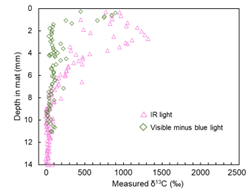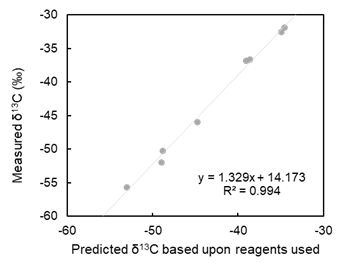Research
Our lab pursues enhanced understanding of a wide range of natural and synthetic systems. The topics listed below, while not exhaustive of all our activities, highlight the lab’s versatility and breadth. Stable isotope analysis is a common component of our work and we merge this tool with a series of other approaches to address significant hypotheses in these areas.
Rhizosphere science: The rhizosphere occupies the interface linking plant roots and soil and it houses a myriad of microbial, plant-directed, and geochemical processes compressed into close spatial confines. The rhizosphere forms a gateway for plant uptake of soil-supplied nutrients and, conversely, offers arguably the largest entry point for organic carbon from plants into soil. Rhizosphere’s small physical stature and its inherent location underground complicate resolving long term knowledge gaps and limits our mechanistic understanding of the complex biogeochemical interactions housed in this dynamic environment. Yet, the central role of the rhizosphere in governing plant health, carbon cycling in soil, and landscape-scaled biogeochemical fluxes highlight the critical societal need to elucidate its key interactions and feedbacks. In my lab, we are cognizant of the important role spatial organization and heterogeneity play within the rhizosphere and the influence this organization can play in determining net biogeochemical fluxes and controlling process interactions. A research platform which exclusively leverages analysis of bulk samples collected from these spatially organized systems can obscure critical processes. Embracing the need for in situ context of rhizosphere, we employ a range of spatially specific techniques to help unravel controls on nutrient exchange between plants, microbes, and the geochemical features over a range of different conditions.

We typically employ plants grown in rhizoboxes to enable ease of access to rhizosphere through a plant growth cycle. We use a series of spatially resolved techniques to specifically address hypotheses linked to exchange of carbon and other nutrients between plant, microorganisms, and soil.

Microbial interactions: Microbial mats can occupy some of the most extreme ecosystems on Earth where high temperatures, salinity, or extreme pH limit growth of other organisms. These systems are frequently spatially organized along geochemical, light, or other gradients where some organisms are relegated to specific niches within the mat and others are more widespread. Our lab uses spatially specific approaches to track nutrient entry and sharing in these systems. In many cases, we have employed laser ablation sampling coupled with stable isotope analysis to track carbon entry into microbial mats with the example below showing an experiment performed at Yellowstone National Park. Samples were harvested from Mushroom Spring and underwent a brief incubation with a 13C tracer and under various light filters before being returned to the lab for isotope analysis. The approach clearly delineated a peak in oxygenic photosynthesis driven by visible light located directly above anoxygenic photosynthetic activity found slightly deeper in the mat. Notably, both processes occurred contemporaneously during daylight hours.


Chemical forensics: Stable isotope analysis can play a critical role in assisting chemical forensic efforts, specifically with source attribution and chemical provenance. Our lab seeks to better understanding the inheritance of a stable isotope signature from reagent to a synthesized chemical. A variety of factors can complicate interpretation of this signature and analytical limitations can challenge efforts to direct isotope analysis towards specific portions of a synthesized molecule.




 Print
Print Email
Email